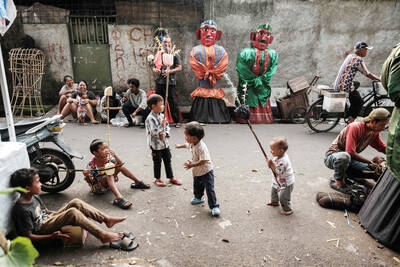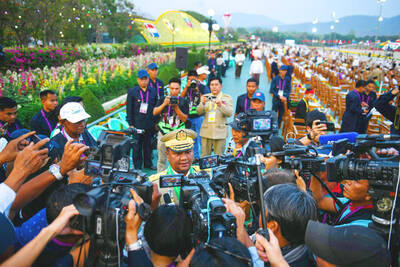When a magnitude 7.8 earthquake rocked Nepal last year, villagers in Changu Narayan ran up the steep rocky path that cuts through their town to their renowned temple. Seeing the piles of rubble, they figured their lives were over.
Less than two years later, the community is cleaning up their World Heritage Site themselves, and one of the world’s leading architects has taken on the recovery as his pet project.
“I see now our world coming back alive,” said Gyan Bahadur Bhadal, 61, one of many villagers who share responsibility for the temple’s upkeep.

Photo: AP
In a country where locals say there are more gods than people and more temples than houses, Changu Narayan still manages to stand out among the ancient holy places. It is believed to be the oldest Hindu place of worship in the country, its wooden walls intricately carved with hundreds of deities, perched atop a steep hill overlooking the Kathmandu Valley.
The fifth-century temple is dedicated to Lord Vishnu, who locals say appeared there once. His image, in about a dozen incarnations, is carved into struts that hold up the roof. Stone lions with eagle heads guard the doors. Inside has long been a mystery: Only priests enter the two-tiered pagoda, and they do not explore.
An April 2015 temblor that killed 9,000 people in Nepal also damaged details in Changu Narayan’s wood, stone and metal. A sharp aftershock one day later twisted the entire structure, knocking piles of bricks out of the walls, filling the courtyard.
Anish Bhatta’s family has been living and leading worship at the temple for 10 generations — about 325 years. After the earthquake, Anish did the unthinkable: He went all the way inside.
“We saw things we never imagined,” he said. “Statues as big as me, swords, so many sculptures, gold plated with big gems.”
Today the temple is guarded by military police and propped up with questionable temporary beams.
British architect John Sanday, who led the World Monuments Fund restoration of Cambodia’s Angkor Wat, the largest religious monument in the world, fell in love with the place decades ago. After the earthquake, he came up the Changu path with trepidation.
“I was very emotional walking into this place. The whole of the courtyard was littered with rubble. I thought: ‘Come on, John, you’ve got to pull yourself together,’” he said.
However, then Sanday noticed wooden supports exposed by the missing brick. He saw what looked like a bedrock foundation, and he decided that of the 600 historical temples, monuments and palaces damaged by the earthquake in Nepal, this one would be his project.
“Sure, it’s peanuts, a little temple, so why is it so special?” Sanday said. “The detail. The grace. It’s one of the few World Heritage Sites that hasn’t been completely destroyed by development.”
However, what really drew him to step in as technical adviser were the people of this village.
Among tourists and pilgrims, Changu Narayan’s residents pray there at dusk, kneel at the deities, bow to the gods, offer alms to the priests who stand duty at the door.
Three people died and 100 homes were damaged in Changu Village, a 30-minute drive from downtown Kathmandu, during the earthquake. Like families in the city 20km away, the Changu community grieved, cried and cleaned up rubble.
However, in the hilltop village the community did something else: With rags and water, little picks and brushes, they cleaned the ancient and exotic carved brackets and facades, cleaning and repairing, bit by bit, so they could resume their worship.
Now Sanday says their dedication is his inspiration.
He said that he would not allow their culture to disappear with the damaged building.
Conserving an ancient building means solving a series of incredibly complicated puzzles. Rotted or mice-chewed timbers must be replaced. An unstable and stretched government bureaucracy must remain in charge. And there is US$300,000 to raise.
For starters, with US$30,000 of German support, he helped the community rebuild one of Changu’s shrines, the size of a little guardhouse. Now he is looking at the larger temple a few yards away.
“This is a place we can save, no doubt,” Sanday said. “The people here will make sure of that.”

In the sweltering streets of Jakarta, buskers carry towering, hollow puppets and pass around a bucket for donations. Now, they fear becoming outlaws. City authorities said they would crack down on use of the sacred ondel-ondel puppets, which can stand as tall as a truck, and they are drafting legislation to remove what they view as a street nuisance. Performances featuring the puppets — originally used by Jakarta’s Betawi people to ward off evil spirits — would be allowed only at set events. The ban could leave many ondel-ondel buskers in Jakarta jobless. “I am confused and anxious. I fear getting raided or even

Eleven people, including a former minister, were arrested in Serbia on Friday over a train station disaster in which 16 people died. The concrete canopy of the newly renovated station in the northern city of Novi Sad collapsed on Nov. 1, 2024 in a disaster widely blamed on corruption and poor oversight. It sparked a wave of student-led protests and led to the resignation of then-Serbian prime minister Milos Vucevic and the fall of his government. The public prosecutor’s office in Novi Sad opened an investigation into the accident and deaths. In February, the public prosecutor’s office for organized crime opened another probe into

RISING RACISM: A Japanese group called on China to assure safety in the country, while the Chinese embassy in Tokyo urged action against a ‘surge in xenophobia’ A Japanese woman living in China was attacked and injured by a man in a subway station in Suzhou, China, Japanese media said, hours after two Chinese men were seriously injured in violence in Tokyo. The attacks on Thursday raised concern about xenophobic sentiment in China and Japan that have been blamed for assaults in both countries. It was the third attack involving Japanese living in China since last year. In the two previous cases in China, Chinese authorities have insisted they were isolated incidents. Japanese broadcaster NHK did not identify the woman injured in Suzhou by name, but, citing the Japanese

RESTRUCTURE: Myanmar’s military has ended emergency rule and announced plans for elections in December, but critics said the move aims to entrench junta control Myanmar’s military government announced on Thursday that it was ending the state of emergency declared after it seized power in 2021 and would restructure administrative bodies to prepare for the new election at the end of the year. However, the polls planned for an unspecified date in December face serious obstacles, including a civil war raging over most of the country and pledges by opponents of the military rule to derail the election because they believe it can be neither free nor fair. Under the restructuring, Myanmar’s junta chief Min Aung Hlaing is giving up two posts, but would stay at the